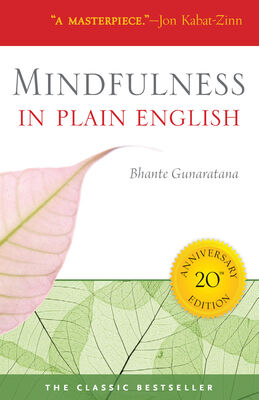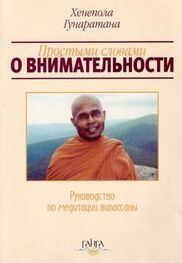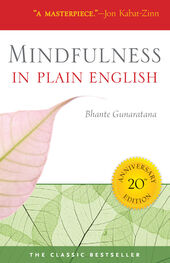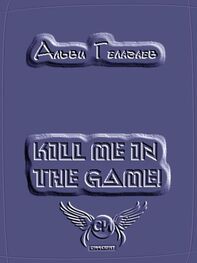Notice the way these apparently smooth motions are composed of complex series of tiny jerks. Try to miss nothing. In order to heighten your sensitivity, you can break the movement down into distinct components. Each foot goes through a lift, a swing; and then a down tread. Each of these components has a beginning, middle, and end. In order to tune yourself in to this series of motions, you can start by making explicit mental notes of each stage.
Make a mental note of “lifting, swinging, coming down, touching floor, pressing” and so on. This is a training procedure to familiarize you with the sequence of motions and to make sure that you don’t miss any. As you become more aware of the myriad subtle events going on, you won’t have time for words. You will find yourself immersed in a fluid, unbroken awareness of motion. The feet will become your whole universe. If your mind wanders, note the distraction in the usual way, then return your attention to walking. Don’t look at your feet while you are doing all of this, and don’t walk back and forth watching a mental picture of your feet and legs. Don’t think, just feel. You don’t need the concept of feet and you don’t need pictures. Just register the sensations as they flow. In the beginning, you will probably have some difficulties with balance. You are using the leg muscles in a new way, and a learning period is natural. If frustration arises, just note that and let it go.
The Vipassana walking technique is designed to flood your consciousness with simple sensations, and to do it so thoroughly that all else is pushed aside. There is no room for thought and no room for emotion. There is no time for grasping, and none for freezing the activity into a series of concepts. There is no need for a sense of self. There is only the sweep of tactile and kinesthetic sensation, an endless and ever-changing flood of raw experience. We are learning here to escape into reality, rather than from it. Whatever insights we gain are directly applicable to the rest of our notion-filled lives.
2. Postures
The goal of our practice is to become fully aware of all facets of our experience in an unbroken, moment-to-moment flow. Much of what we do and experience is completely unconscious in the sense that we do it with little or no attention. Our minds are on something else entirely. We spend most of our time running on automatic pilot, lost in the fog of day-dreams and preoccupations.
One of the most frequently ignored aspects of our existence is our body. The technicolor cartoon show inside our head is so alluring that we tend to remove all of our attention from the kinesthetic and tactile senses. That information is pouring up the nerves and into the brain every second, but we have largely sealed it off from consciousness. It pours into the lower levels of the mind and it gets no further. Buddhists have developed an exercise to open the floodgates and let this material through to consciousness. It’s another way of making the unconscious conscious.
Your body goes through all kinds of contortions in the course of a single day. You sit and you stand. You walk and lie down. You bend, run, crawl, and sprawl. Meditation teachers urge you to become aware of this constantly ongoing dance. As you go through your day, spend a few seconds every few minutes to check your posture. Don’t do it in a judgmental way. This is not an exercise to correct your posture, or to improve you appearance. Sweep your attention down through the body and feel how you are holding it. Make a silent mental note of ‘Walking’ or ‘Sitting’ or ‘Lying down’ or ‘Standing’. It all sounds absurdly simple, but don’t slight this procedure. This is a powerful exercise. If you do it thoroughly, if you really instil this mental habit deeply, it can revolutionize your experience. It taps you into a whole new dimension of sensation, and you feel like a blind man whose sight has been restored.
3. Slow-Motion Activity
Every action you perform is made up of separate components. The simple action of tying your shoelaces is made up of a complex series of subtle motions. Most of these details go unobserved. In order to promote the overall habit of mindfulness, you can perform simple activities at very low speed—making an effort to pay full attention to every nuance of the act.
Sitting at a table and drinking a cup of tea is one example. There is much here to be experienced. View your posture as you are sitting and feel the handle of the cup between your fingers. Smell the aroma of the tea, notice the placement of the cup, the tea, your arm, and the table. Watch the intention to raise the arm arise within your mind, feel the arm as it raises, feel the cup against your lips and the liquid pouring into your mouth. Taste the tea, then watch the arising of the intention to lower your arm. The entire process is fascinating and beautiful, if you attend to it fully, paying detached attention to every sensation and to the flow of thought and emotion.
This same tactic can be applied to many of your daily activities. Intentionally slowing down your thoughts, words and movements allows you to penetrate far more deeply into them than you otherwise could. What you find there is utterly astonishing. In the beginning, it is very difficult to keep this deliberately slow pace during most regular activities, but skill grows with time. Profound realizations occur during sitting meditation, but even more profound revelations can take place when we really examine our own inner workings in the midst of day-to-day activities. This is the laboratory where we really start to see the mechanisms of our own emotions and the operations of our passions. Here is where we can truly gauge the reliability of our reasoning, and glimpse the difference between our true motives and the armor of pretense that we wear to fool ourselves and others.
We will find a great deal of this information surprising, much of it disturbing, but all of it useful. Bare attention brings order into the clutter that collects in those untidy little hidden corners of the mind. As you achieve clear comprehension in the midst of life’s ordinary activities, you gain the ability to remain rational and peaceful while you throw the penetrating light of mindfulness into those irrational mental nooks and crannies. You start to see the extent to which you are responsible for your own mental suffering. You see your own miseries, fears, and tensions as self-generated. You see the way you cause your own suffering, weakness, and limitations. And the more deeply you understand these mental processes, the less hold they have on you.
4. Breath Coordination
In seated meditation, our primary focus is the breath. Total concentration on the ever-changing breath brings us squarely into the present moment. The same principle can be used in the midst of movement. You can coordinate the activity in which you are involved with your breathing. This lends a flowing rhythm to your movement, and it smooths out many of the abrupt transitions. Activity becomes easier to focus on, and mindfulness is increased. Your awareness thus stays more easily in the present. Ideally, meditation should be a 24 hour-a-day practice. This is a highly practical suggestion.
A state of mindfulness is a state of mental readiness. The mind is not burdened with preoccupations or bound in worries. Whatever comes up can be dealt with instantly. When you are truly mindful, your nervous system has a freshness and resiliency which fosters insight. A problem arises and you simply deal with it, quickly, efficiently, and with a minimum of fuss. You don’t stand there in a dither, and you don’t run off to a quiet corner so you can sit down and meditate about it. You simply deal with it. And in those rare circumstances when no solution seems possible, you don’t worry about that. You just go on to the next thing that needs your attention. Your intuition becomes a very practical faculty.
Читать дальше





